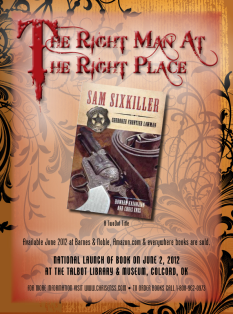This is the last week to enter to win a copy of the award winning book
Sam Sixkiller: Cherokee Frontier Lawman
It was a warm September evening in 1886 when the citizens of Muskogee gathered in the center of town to enjoy a concert given by the Muskogee Amateur Italienne Musical Society. Horses and wagons lined the streets. The performers tuned their instruments and greeted crowd members anxious to express their support for them. Excited children chased one another around and families jockeyed for the best positions in front of a crude bandstand. Women huddled together in discussions of their own and comforted the infants with them that were unsettled by the flurry of activity.1
Before the event had officially begun, the sound of rapid gunfire echoed off the buildings that framed the main thoroughfare. The gunshots grew louder and suddenly a pair of horsemen appeared riding pell-mell toward the congregation. People scattered. Running for cover, they disappeared into businesses and homes. The cries of astonishment and fear from the unassuming townspeople had no effect on the two rides. Black Hoyt, a half-blooded Cherokee Captain Sixkiller had previous dealings with, and a white man named Jess Nicholson gouged the spurs on their boots into the sides of their mounts and charged down the street, shooting their weapons at anything that moved.2
The out of control men were drunk and enjoying the chaos derived by their wild behavior. Captain Sixkiller and the police officers that worked with him, including Charles LeFlore, rushed onto the scene brandishing their own guns. The captain shouted at Black and Nicholson to stop, but the men took their time at it. After a few moments waiting for the two rowdies to do as they were told, the Muskogee police force managed to corner the riders. LeFlore ordered them to throw their pistols down, and Captain Sixkiller informed them they were under arrest. Neither of the men complied.3
A tense hush filled the air as Black and Nicholson considered their options. The captain studied the belligerent looks on their darkly flushed features. “Give us your guns now,” he demanded, “before someone gets hurt.” Black shifted in his saddle and rubbed off the sweat standing on his chin with his right shoulder. His arm was missing from the elbow down, and his shirtsleeve was pinned over the remaining portion of the limb. Black had lost his arm in June 1886, after he was shot by an unknown assailant while at Fort Gibson, Oklahoma. A bullet fractured the lower third of the appendage, and amputation was his only chance of recovery. Black and his father objected at first but, after conferring with a second doctor, realized there was no other option. He recovered quickly from the chloroform, and as soon as he could left the post doctor’s office to avoid any further attempts on his life. With Milo’s help, he learned how to ride and shoot holding the reins of his horse and pistol in the same hand.4
To learn more about the life and times of Sam Sixkiller read
Sam Sixkiller: Cherokee Frontier Lawman


